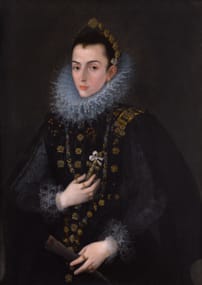
uan Pantoja de la Cruz
(Valladolid 1553 - Madrid 1608)
 Biography
Biography Portrait of a Lady of the Court of Philip III
Biography
Juan Pantoja de La Cruz was a Spanish painter, one of the best representatives of the Spanish School of court painters.
Very little is known of the formative years of Pantoja as a painter. He was a pupil of the court painter Alonso Sànchez Coello (1531/32-1588) in Madrid and he must have assisted him in complying with his duties as painter of the Spanish King Philipp II (1527-1598). Pantoja probably continued to work in his master studio after completing his training. He married in 1585, beginning to paint for the court around that time. After Sànchez Coello’s death, Pantoja took over his master workshop and became court painter to Philip II of Spain.
Pantoja kept working for the court and the nobility. After Philipp II’s death, Philip III (1578-1621) confirmed Pantoja’s status as court painter. When the court settled in Valladolid in 1601, Pantoja moved to the new capital, remaining in this city several years.
Pantoja painted a great number of state portraits with the combined forces of his studio, his attendants, apprentices and collaborators. He was primarily a portrait painter to the royal family and to the higher aristocracy. Pantoja also painted religious works, primarily commissioned by the Spanish Queen Margarita of Austria (1584-1611), wife of Philip III. Pantoja painted still lifes as well but, like his ceiling frescoes, these have not survived.
Juan Pantoja de La Cruz represents one of the highest points in the Mannerism aesthetic of portrait painting. He followed the Spanish tradition of royal portraits, initiated with the famous portrait of Charles V (1500-1558) by Titian (c.1493/1490-1576). His art was severly criticised by historians who were prejudiced against non-Italian portraiture, and therefore dismissed him as un “uninspired, dull” though “painfully hard-working” painter at the court of Philip III.
In his best works, Pantoja introduced an impressive combination of sophistication and geometric abstraction achieved by means of powerful contrast of light and shadow. His portraits are noted for the meticulous detail of representing the intricate embroidery of dresses and jewellery designs. The subject is usually portrayed standing against a dark background. the face and hands are depicted with a more flat and subtle technique.
Pantoja was also a highly versatile painter at home in all genres. He supplied the Spanish court and the aristocracy with religious paintings, mythological canvases and historical compositions, pantoja’s religious paintings are executed with a more realistic and dramatic style than his portraits. they range from a coldly distant academism to a more advanced temebrism close to the Baroque.
Juan Pantoja de La Cruz was held in high esteem as a animal painter. He was also known as a landscape and still life painter who exploited the new secularized art forms that spread across Europe at the close of the sixteenth century.
Pantoja returned with the court to Madrid and died there on 26 October 1608.









